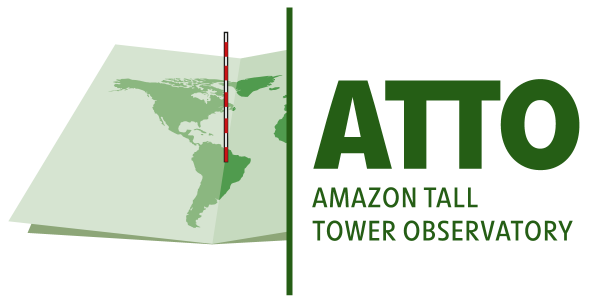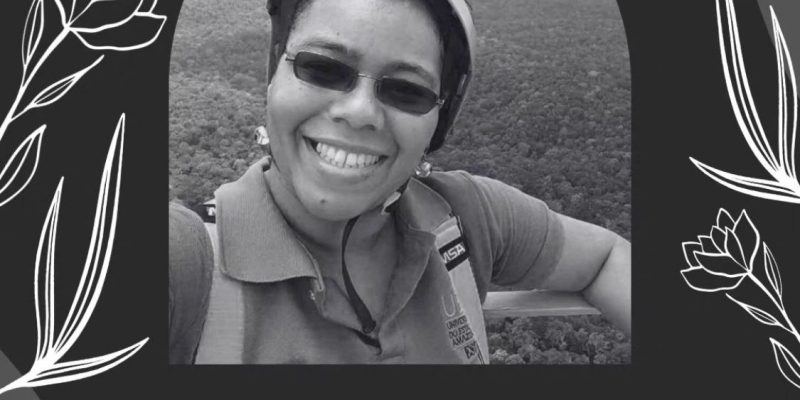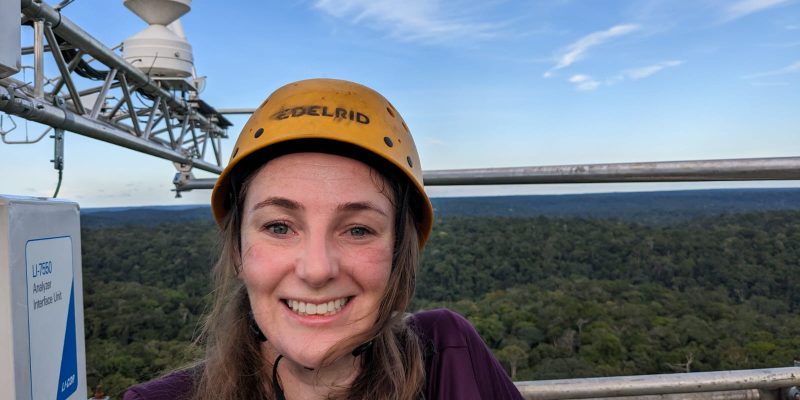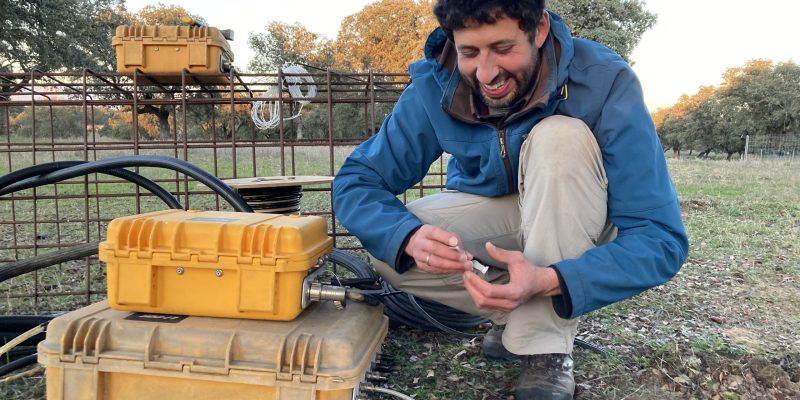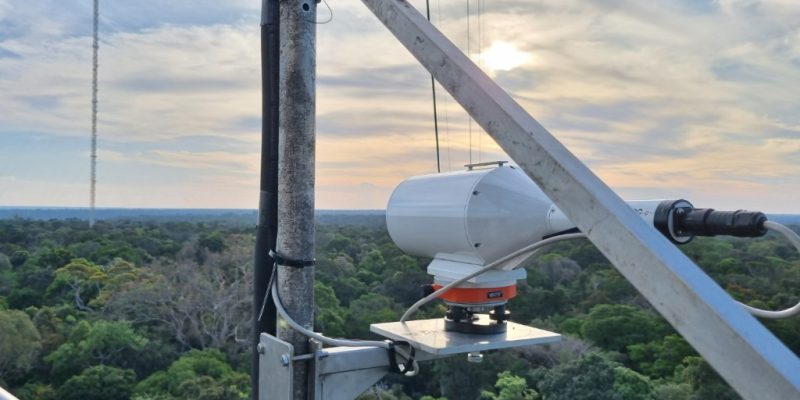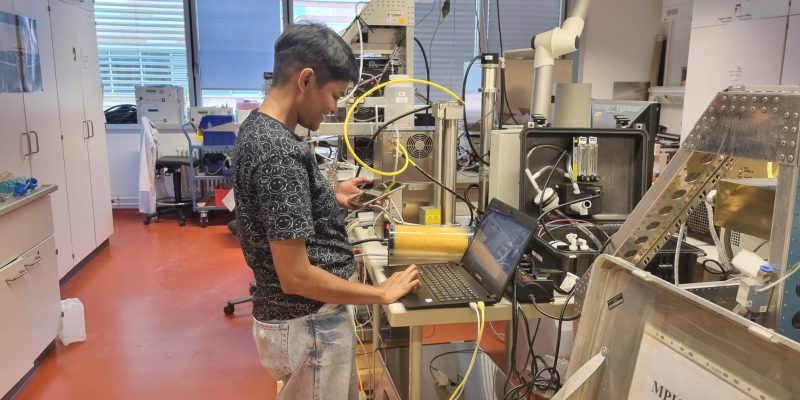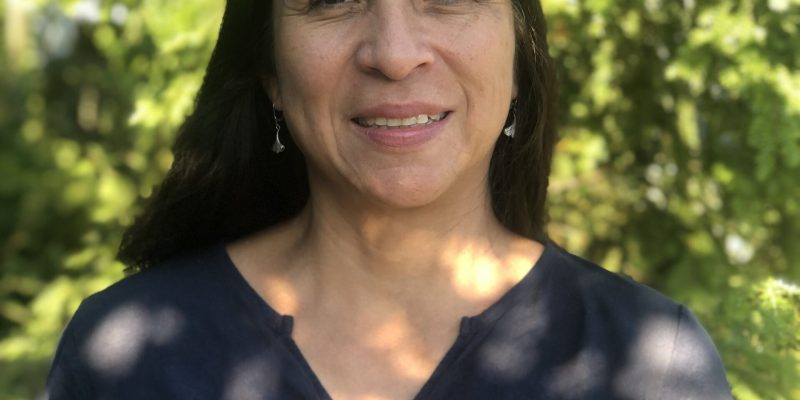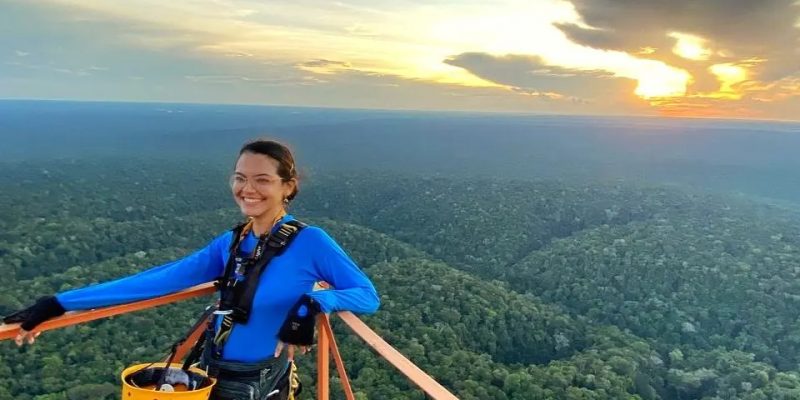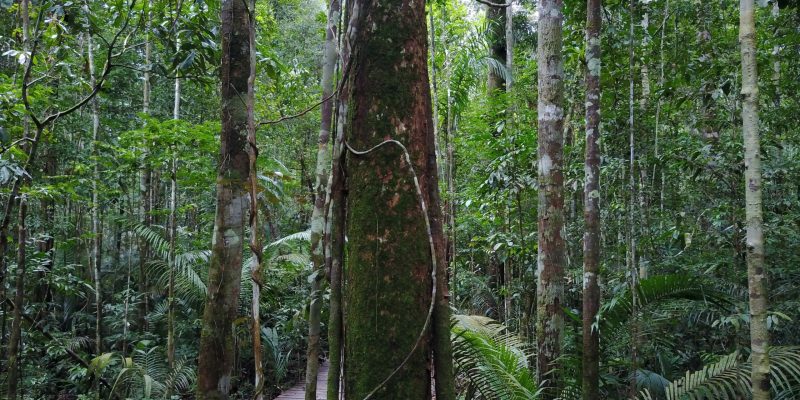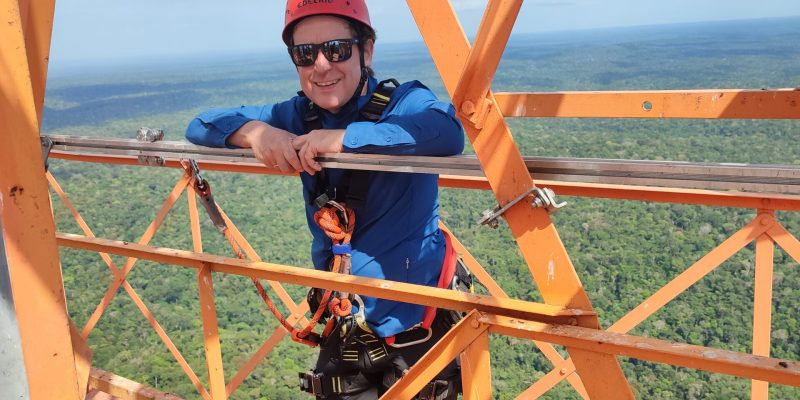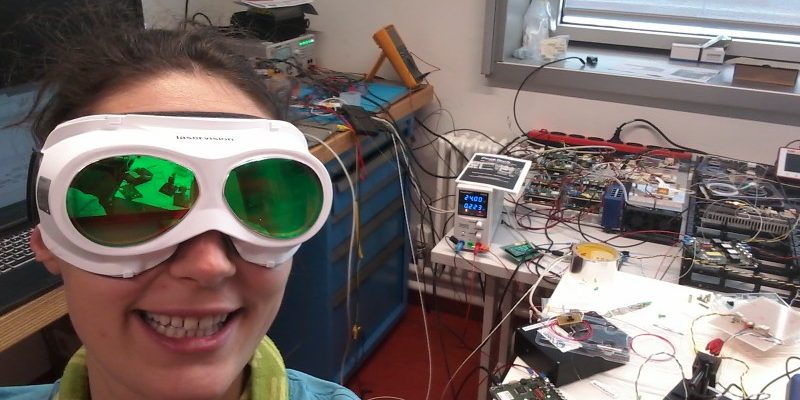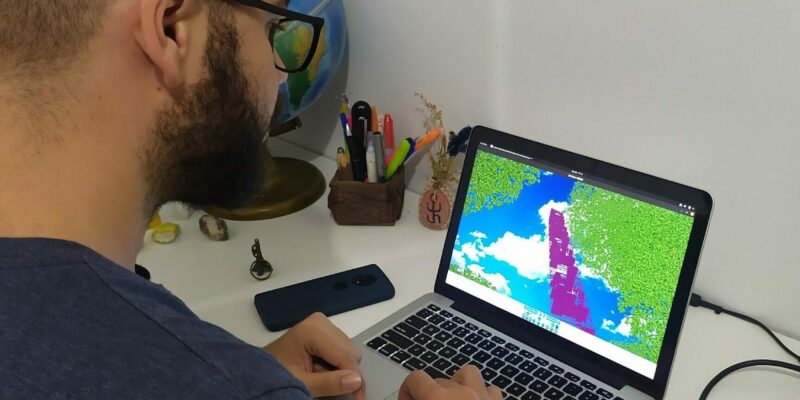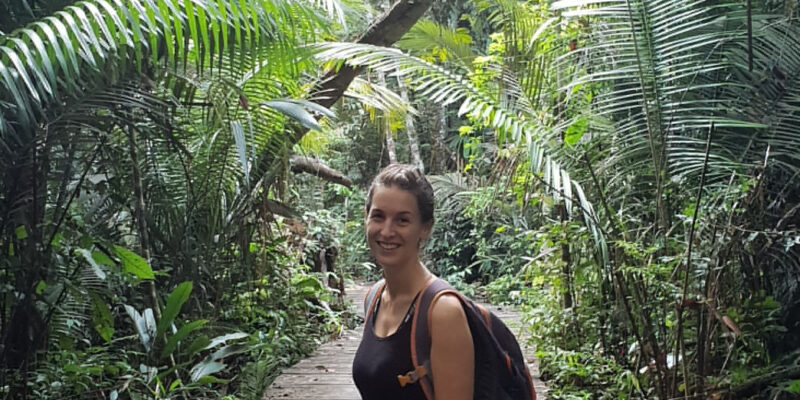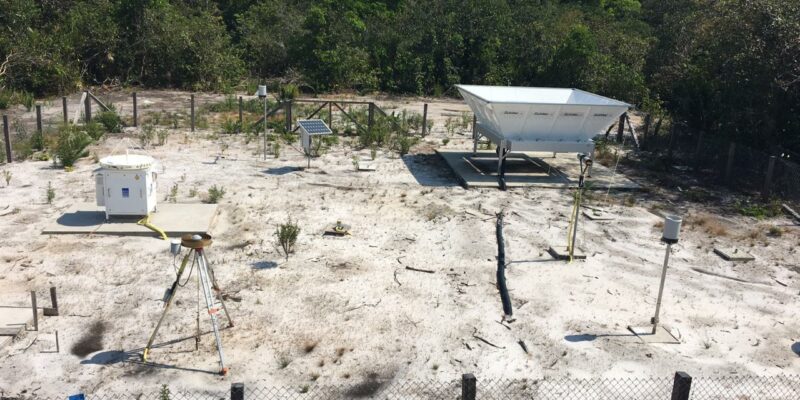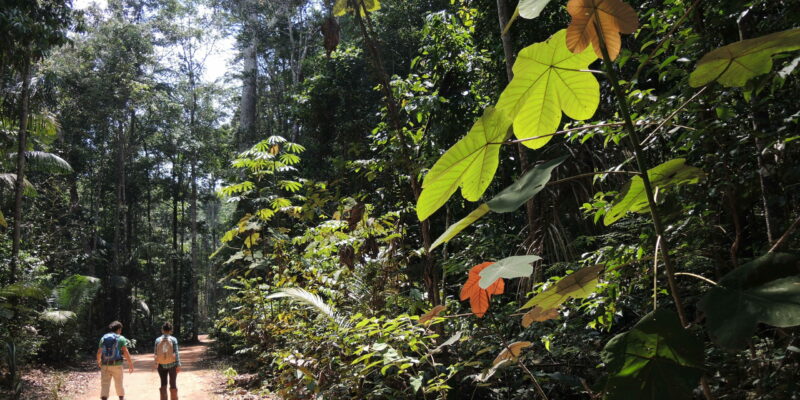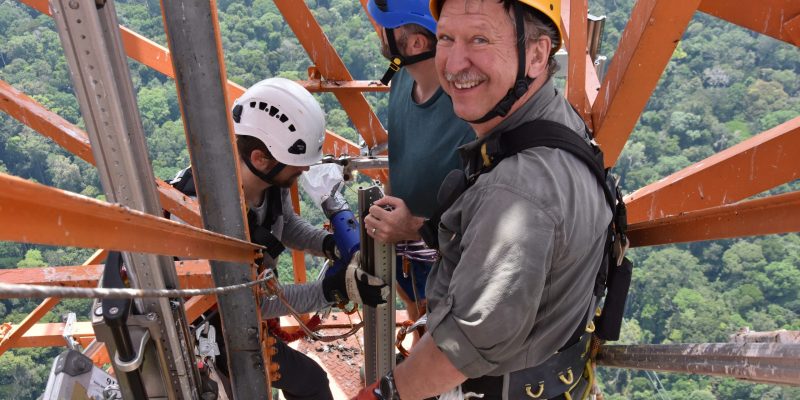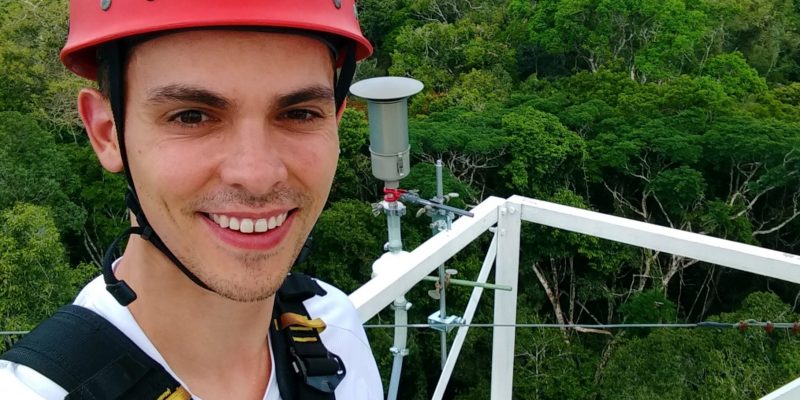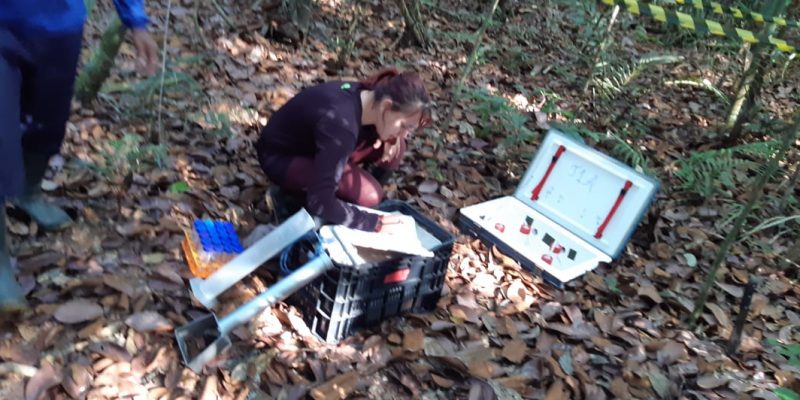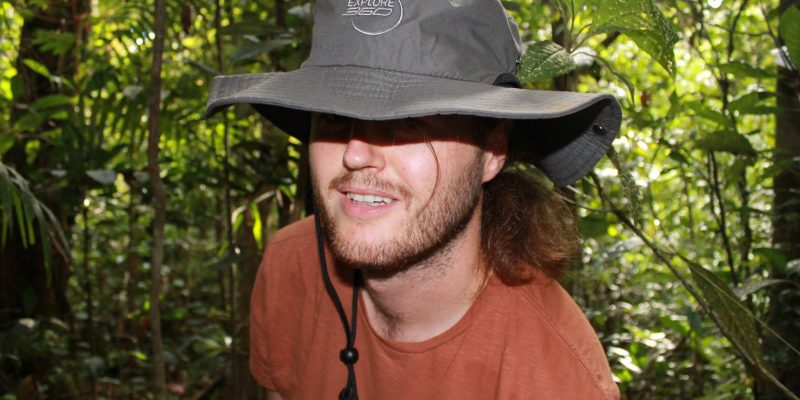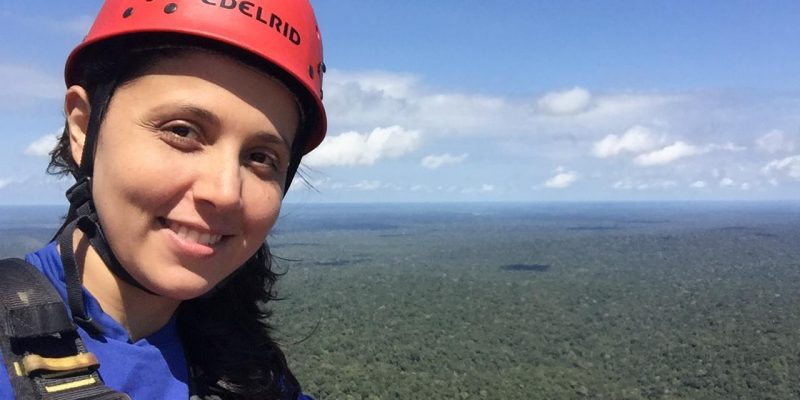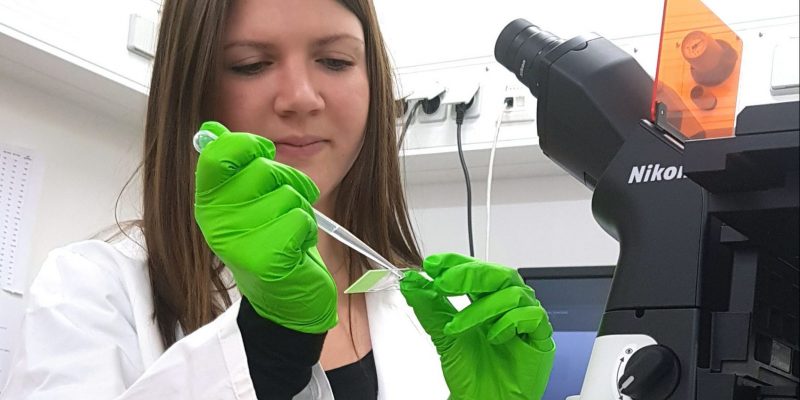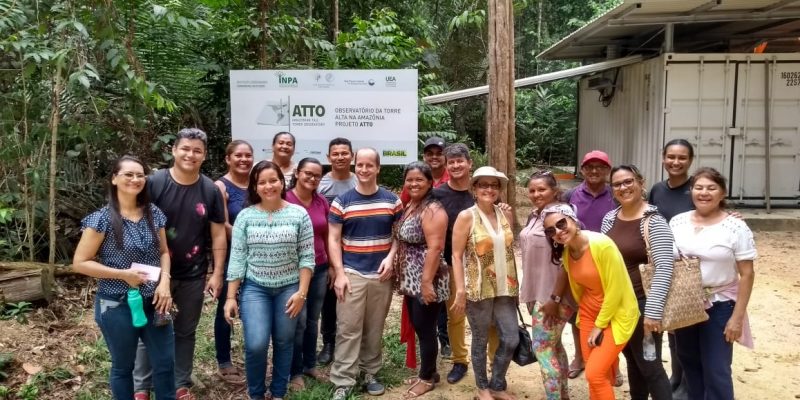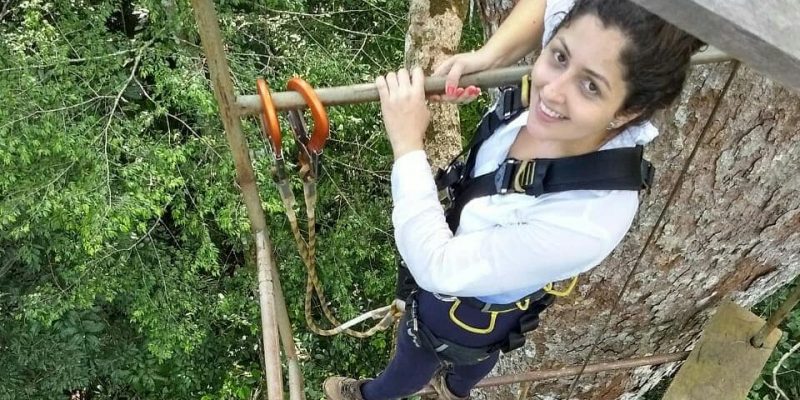Hi there, my name is Juliana. I am the new ATTO Scientific Data Manager working at the Max Planck Institute for Biogeochemistry. I come from south Brazil where I studied Biology. I moved to Manaus in 2009 to pursue a Master in Ecology at INPA. Throughout my academic career I have also acquired experience in research data management.
Hi everyone, my name is Fernanda! I am a Post Doc at National Institute for Amazonian Research in Manaus (Brazil). Along with collaborators at INPA and MPI-BGC, I am working on methane fluxes from tree stems in the different ecosystems present at ATTO.
With great sadness, we acknowledge the passing of Dr. Rosa Maria Nascimento dos Santos, meteorologist, Professor at the Universidade do Estado do Amazonas (Amazonas State University, EUA) and a very important member of the ATTO team.
With "Mission ATTO", the research project ATTO sends German students from grade 8 onwards on a fictional research trip to the Brazilian rainforest.
Hello, everyone! My name is Carla Webber and I’m the new post-doc in the Cryptogamic communities group at the ATTO. I’m a biocrust researcher and have worked on this subject for more than ten years. Biocrusts taught me to be an interdisciplinary researcher.
My name is Tarek S. El-Madany and I’m the new head of the Central Service Group “Field Experiments and Instrumentation” at MPI-BGC in Jena. I am taking over from Olaf Kolle, who will be retiring this year. I’m a trained landscape ecologist and specialized in micrometeorology.
I want one! This was the enthusiastic reaction of a Brazilian student after her first encounter with a scintillometer at the CloudRoots campaign in Amazonia. The scintillometer is indeed a special instrument that deserves admiration.
I am Subha and I like to call myself an interdisciplinary researcher. I did civil engineering for my bachelor’s degree, and for my master’s degree, I worked on the applications of remote sensing and GIS. Now I work full-time at Max Planck Institute for Chemistry in Mainz with a wonderful team led by Christopher Pöhlker.
My name is Stefanie Hildmann and I am currently a PhD student in the group ‘Organic Trace Analysis’ of Prof. Thorsten Hoffmann at the Johannes Gutenberg – University of Mainz (Germany). In my PhD, I want to characterize secondary organic aerosols (SOA) chemically at the molecular level.
Hi, my name is Viviana Horna. This April 2022 I started working at the Max Planck Institute for Biogeochemistry as the new scientific coordinator of the ATTO project. I studied tropical forestry in Peru for my BSc, where I am from.
Hi everyone, my name is Anna Moraes! I started recently as a Ph.D. student at the National Institute of Amazonian Research (INPA), in Manaus, in the group of Dr. Eliane Gomes Alves. My project focuses on herbivore-induced plant volatiles (HIPVs).
Achim Edtbauer wrote a blog for the Nature Community Ecology and Evolution. He shares insights about how his latest paper came to be, and what it is like to study mosses and lichens at ATTO as an atmospheric physicist.
The Amazon rainforest has an enormous turnover of greenhouse gases. The only way to find out how this turnover will develop over time is to measure it regularly. Therefore, my colleagues and I, recently installed a flask sampler set-up to automatically collect air samples to establish a time series of greenhouse gas measurements at ATTO. My name is Markus Eritt, I am a laboratory head at the ICOS Central Analytical Laboratory in Jena, which is located at the MPI-BGC.
Hello, I am Adriana Simonetti. I just finished my Master in Tropical Forest Sciences at the National Institute for Amazon Research (INPA). I quantified canopy gaps in the Amazon from aerial photographs collected during repeated drone flights. I deeveloped this techinque in the scope of the ATTO project, under the supervision of Dr Daniel Marra.
Hi everybody, my name is Carolina. Since recently, I am a Ph.D. student in the workgroup “Radical measurements” of Hartwig Harder in the atmospheric chemistry department at Max-Planck Institute for Chemistry in Mainz.
My name is Ingrid Chanca and I am a physicist. I am currently pursuing my PhD at the Max Planck Institute for Biogeochemistry, in Jena, Germany and the Universidade Federal Fluminense, in Niterói, Rio de Janeiro. For my research, I am particularly interested in radiocarbon. To be able to measure radiocarbon in air samples, I have built the GASPS, a Gas Samples’ Purification System.
Hi there, my name is Renato Braghiere! I’m a climatologist and global ecologist at NASA Jet Propulsion Laboratory in California and I have worked on the ATTO project during my MSc degree from 2011 to 2013. I grew up in the countryside of the state of São Paulo in Brazil amid the trees, and from my early years, I’ve been curious about how nature works and how we connect with nature in so many different ways.
My name is Maryam and I am currently working as a research data manager at MPI-BGC. I have a background in geophysics and lots of prior experience with data management so that I can now take care of the ATTO data portal.
Hello everyone, my name is Frederik Lange. I started recently as a Ph.D. student at the Max Planck Institute for Biogeochemistry in Jena. Here, I work in the Molecular Biogeochemistry group with Gerd Gleixner as my supervisor.
Hello everyone, my name is Jeová Ramos da Silva Junior. I am a meteorologist and had my first contact with ATTO at the beginning of my master’s degree in 2017. During this period, I investigated how biomass burning might affect photosynthesis inside the canopy of the Amazon Rainforest.
My name is Maria Prass and I’m a PhD student at the Max Planck Institute for Chemistry in Mainz in the group of Christopher Pöhlker who’s focused on aerosol analytics. Born in the countryside, the forest and all its small to large inhabitants are fascinating me up even today. Studying biology seemed to be the perfect match for me. Who would have thought, that this would move me to be a scientist in the most beautiful but at the same time endangered ecosystem in the world: the Amazon rainforest?
My name is Eva Pfannerstill, and I studied OH reactivity in different environments, including the Amazon rainforest. When I first opened the lid of the Comparative Reactivity instrument, I felt like looking at a bowl of Teflon spaghetti: The dozens of thin tubes, valves and mass flow controllers inside make up a confusing network for gas flows and reactions. Its purpose is the measurement of the so-called total OH reactivity. The OH reactivity tells us how much hydroxyl (OH) radicals are lost per unit of time in ambient air.
Hello! My name is Camila Lopes. I’m a meteorologist working in the ATTO Project since 2020. It is part of my Ph.D. studies at the University of São Paulo, Brazil, under the supervision of Prof. Rachel Albrecht. I’m involved in a project to study the lifecycle of clouds and aerosols in the Amazon by measuring their properties in several locations. One of these locations includes the ATTO Tower and a new site assembled about 4-km away from the tower. The site is called "Campina", which means "meadow" in Portuguese.
Shujiro Komiya is a postdoc at MPI-BGC. He got his degrees at Meiji University in Tokyo and has a background in studying greenhouse gas dynamics in rice paddy fields. He now applies this in the Amazon rainforest at ATTO.
Eva Pfannerstill remembers her time in the ATTO project, and what it was like to perform research at a remote site in the Amazon Rainforest. The article was first published on EGU Blogs.
Marco Franco is a PhD student at the University of São Paulo (USP), in São Paulo, in the group of Prof. Paulo Artaxo. For his thesis, he studies the properties of aerosols in the Amazon and how they vary with height.
My name is Stefan! I’m a meteorologist and I have been working on the ATTO project since 2010. I heard about the Amazon Rainforest for the first time in my childhood. From that moment on I was really enthusiastic about this abundant ecosystem and passionate to get to know it.
Hi, my name is Akima! I studied meteorology at the University of Frankfurt. But back then I realized that I would love to work in the field instead of only sitting at my desk. When I was looking for options after graduation, there was an opportunity to participate in the ATTO project. I thought this was a fantastic chance to combine my background with exciting fieldwork and so I became PhD student at MPI-C in Mainz.
I’m Eliane Gomes-Alves. I have been working at ATTO since 2015 with measurements of plant emissions of Volatile Organic Compounds (VOC). To sample VOC emissions, we use equipment that was originally developed to measure gas exchanges between the air and plant leaves. It is called IRGA – infrared gas analyzer.
My name is Andrew Crozier and I have been the Site Engineer in the ATTO project for the last 6 years. Now my time with the ATTO project is coming to a close. And though I am saddened to leave it, I will always be grateful for the life-changing experiences I have had while connected with it.
My name is Sebastian and I am a biologist participating in the ATTO project since 2017. At the moment I am working on my master thesis on "Bioaerosol emission patterns of tropical fungi in the Amazon”Bioaerosols are particles in the atmosphere originating from a biological source, for example fungal spores, bacteria and viruses. The fungal spores are what interests our research team. Together with multiple colleagues, in particular Nina Löbs and Cybelli Barbosa, I developed a measurement setup, with which we can quantify and analyze fungal particle emissions in the field and in the lab.
The news reaching us from Brazil, and in particular from Manaus, these days are very grim. On behalf of the ATTO partners from Germany and elsewhere, I would like to express our concern and support for our colleagues in Brazil.
Hello everyone, my name is Pedro. I am a biologist and a lover of the world of plants. I first realized this during my undergrad. As an intern at the Institute of Botany of São Paulo, I participated in an ozone bio-monitoring project. Basically, it was all about exposing sensitive plants to this pollutant, ozone, in several locations around an oil refinery. After a few days of exposure, I looked at the leaves and checked if and to what degree they have injured due to the ozone.
My name is Olaf Kolle and I am the scientific head of the Central Service Group ‘Field Experiments and Instrumentation’ at the MPI-BGC in Jena. Currently, we are 13 people in this Service Group. I myself am a meteorologist. But our group members have a wide range of backgrounds, from scientists over gardeners to engineers. This means that we have accumulated a large amount of technical and scientific expertise to plan, set up and maintain field installations.
Hello everybody, my name is Hella van Asperen. I am a PostDoc at the Institute of Environmental Physics in Bremen (Germany), in the group of Prof. Notholt, but currently live and work in Manaus. I started my studies at Wageningen University in the Netherlands with the Bachelor program ‘Soil, Water, Atmosphere’. That I followed with a Masters in ‘Soil Science’ and ‘Earth System Science’.
Hello everybody, I am Milena Ponczek. I am a post-doc at the Laboratory of Atmospheric Physics at the University of Sao Paulo. About one year ago, I joined Prof. Artaxo’s group there. For my current project that includes ATTO, we focus on aerosols life cycle in the Amazon. I investigate secondary organic aerosol formation from the oxidation of Biogenic VOCs and their subsequent photochemical processing.
Hello together. My Name is Denis Leppla and I am working at ATTO since 2017 with rather simple instruments for filtering aerosol particles from the air. There we analyze them with a mass spectrometer at the Max Planck Institute for Chemistry in Mainz. With this analysis, we can get insights into the chemical composition of aerosol particles and identify hundreds of different compounds.
On today's International Women in Science Day, we want to shine the spotlight on the incredible women in our project. Sue, Samara and Mira tell their inspiring stories of why they wanted to becomes scientists. They share memories of teachers, parents, book and childlike curiosity. They also talk about how they got to where they are today, and what it took to have successful careers as women in science.
Hi, my name is Ana Caroline, and I currently work at the ATTO Project for the INPA and the MPI-BGC. At ATTO I work as a scientific assistant for the Gerd Gleixner group.
My name is Sebastian Donner and I am a PhD student working in the satellite remote sensing group at the Max-Planck-Institut für Chemie in Mainz. I studied Meteorology in Mainz and then stayed here to obtain my Bachelor's and Master's degrees. Already back then, I was really fascinated by the atmosphere’s composition.
Hey, this is Sam Jones! Earlier in 2019 I finally moved to Manaus and took a job at INPA. I say finally because I had flirted with the idea for quite some time. Now I often get asked the enduringly difficult question “What are you doing here?”. The short answer is that I’m working as a soil ‘biogeochemist’ on the ATTO project.
My name is Flavia Durgante and I am a Postdoc in the Wetland Ecology Group of Dr. Florian Wittmann at the Karlsruher Institut für Technologie (KIT), Germany. At ATTO, our project focuses on water. We're analyzing water isotopes from different sources such as rain, soil deeps, rivers and xylem water from trees in different habitats. Additionally, we want to recognize climatic signals as oxygen isotopes in the tree rings.
Hey everyone, my name is Rodrigo Alves. I started my Post Master position in the ATTO project in May of 2019. I’m a biologist and graduated from the Federal University of Pampa (Rio Grande do Sul, Brazil). During my studies, I worked with the effect of climate change on plant communities in Antarctica and participated in three Antarctic expeditions. Now, I have the chance to learn more about those effects in the Amazon rainforest.
Hello everyone, my name is Leslie Kremper and I started my Ph.D. in November of 2018. I’m a biologist and I will analyze the morphology, composition and hygroscopicity of single aerosol particles from the Amazon with different techniques.
We want to share with you some news about an
Hello everyone, my name is Debora Pinheiro. I am a newcomer of the ATTO project and started my Ph.D. at INPA earlier this year. I’m a biologist and I love working with plants! In my Ph.D. project I get to look into the interaction of physical, chemical and biological factors and how they regulate how VOCs are released into the atmosphere.
I'm Michelle Robin and I am in the first year of a Master’s in Ecology program at the INPA. I have a Bachelor’s degree in Biological Sciences and during my undergraduate, I had the opportunity to explore many different fields in biology, from microbiology to herpetology. But I was always mostly interested in plant sciences.
